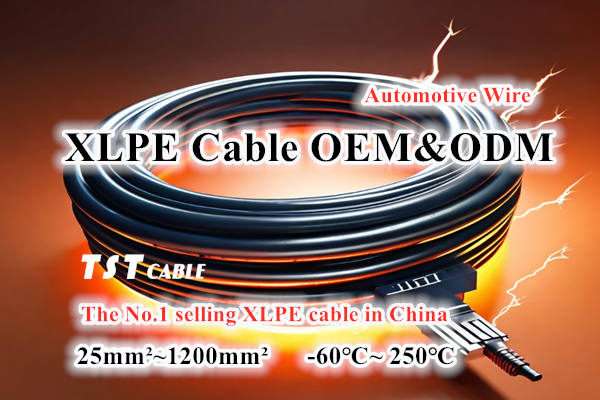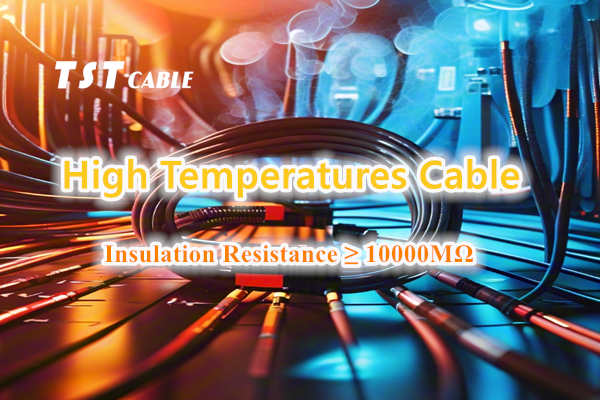Cross-Linked Polyethylene (XLPE) cables are a type of cable widely used in modern power transmission systems. The main feature of XLPE cables is that their insulation materials have been cross-linked, which makes the cables have better heat resistance, mechanical strength and chemical stability, suitable for power transmission at higher voltage levels, and more convenient in terms of laying and installation.

What is XLPE cable?
XLPE cable (cross-linked polyethylene) is a type of cable commonly used in power transmission and distribution. XLPE cable is made of thermosetting material, which means it has strong resistance to heat, moisture and chemicals. This makes it ideal for applications where the cable is exposed to harsh environmental conditions, such as underground or underwater installation.
XLPE insulation material is made by chemically cross-linking polyethylene molecules. This process improves the strength and stability of the material and its ability to withstand high temperatures and electrical stress. XLPE cables have higher operating temperatures than PVC (polyvinyl chloride) insulated cables.
What are the advantages of XLPE?
XLPE’s advantages make it a top choice for applications where electrical insulation, chemical resistance, thermal stability, and mechanical strength are critical. Its versatility and reliability make it widely used in power transmission, cable manufacturing, automotive, aerospace, and other industries. XLPE insulation performs well in both high and low temperatures. Due to its structure, XLPE is extremely resistant to abrasion and other wear and tear. It also has the ability to withstand high voltage electricity, chemicals, and other hazardous materials. Cross-linked polyethylene insulation is also a more affordable option.
When should XLPE cable be used?
XLPE cable is commonly used in a variety of applications, including building power distribution, industrial facilities, and utility grids. It is available in a variety of sizes and configurations, including single-core, multi-core, and shielded cables. It can also be used in low-voltage, medium-voltage, and high-voltage cross-linked polyethylene applications.
In short, XLPE cable should be used in industries where the wires and cables are exposed to the following environments:
Extreme temperature conditions (high and low temperatures)
High-voltage electrical applications
Abrasion and pressure
Water and other liquids
Chemicals and other hazardous materials
XLPE cables can be used in pipelines, mining, and a variety of electrical applications. Cross-linked polyethylene cables can also be used throughout the chemical industry and in the commercial and residential heating industries. Don’t forget grounds maintenance at dentist offices and other medical facilities, stadiums and other venues, and more.
What is the difference between XLPE insulation and PVC insulation?
As mentioned above, XLPE is a cross-linked polyethylene material. PVC stands for polyvinyl chloride insulation.
The main difference is that XLPE can be used in both high-tension and low-tension applications. Its structure is highly resistant to abrasion, pressure, and other wear and tear. PVC insulation cannot withstand such high pressures, which means it is only suitable for low-tension applications.
Other differences:
XLPE insulation has a longer service life than PVC insulation
XLPE is more environmentally friendly because it does not contain chlorides
XLPE insulation can withstand higher temperatures
Cross-linked polyethylene has a stronger resistance to moisture
What are the different types of XLPE insulated cables?
XLPE (cross-linked polyethylene) insulated cables are widely used in power transmission and distribution systems due to their excellent electrical, thermal, and mechanical properties. XLPE insulated cables are divided into different types based on their application, construction, and rated voltage. Here are some common types:
Low voltage XLPE insulated cables: These cables are designed for low-voltage distribution networks with rated voltages up to 1kV. They are commonly used in homes, offices, and industrial applications.
Medium Voltage XLPE Insulated Cables: These cables are designed for use in medium voltage distribution networks rated up to 35kV. They are used for power transmission and distribution in industries, commercial complexes, and residential areas.
High Voltage XLPE Insulated Cables: These cables are designed for use in high voltage transmission networks rated up to 500kV. They are used for long distance power transmission and distribution between power plants and substations.
Armored XLPE Insulated Cables: These cables have an additional layer of protection in the form of steel wire or tape armoring. They are used in applications where the cables are exposed to mechanical stress, such as underground or underwater installations.
Unarmored XLPE Insulated Cables: These cables do not have any armoring and are used in applications where there is no risk of mechanical stress.
Fire Resistant XLPE Insulated Cables: These cables are designed to maintain their electrical properties even in the event of fire. They are used in buildings, tunnels, and other applications where fire safety is critical.
Instrumentation XLPE Insulated Cables: These cables are used in instrumentation and control systems where signal transmission is critical. They have low capacitance and high insulation resistance to ensure reliable signal transmission.
Common fault problems of XLPE cables
1. Insulation failure:
Electrical effect: operating voltage, overvoltage, overload, etc. may cause partial discharge aging, electrical tree aging or water tree aging.
Thermal effect: abnormal temperature and hot and cold cycles may cause thermal aging or thermo-mechanical aging.
Chemical effect: chemical corrosion or oil immersion can cause chemical corrosion or chemical tree phenomenon.
Mechanical effect: mechanical impact, extrusion or trauma may cause mechanical damage or degeneration.
Biological effect: animal gnawing or microbial corrosion may cause holes or short circuits.
2. Cable accessory failure:
Operational errors that may occur during installation, such as the introduction of moisture, metal particles or other impurities; damage to the main insulation; corners on the conductor connector; poor crimping leading to air gaps and other problems.
Over time, the electric field strength at the cut-off point of the shielding layer in the cable accessories is concentrated, which is easy to cause partial discharge, and eventually lead to electrical breakdown or collapse of the insulating medium of the cable accessories.
3. Aging problem:
The aging process of cables is an irreversible process. As the service life increases, the cables will gradually age due to electrical, thermal, mechanical and environmental factors, which will reduce the electrical performance of the cables and increase the risk of failure.
4. Diagnosis and positioning technology challenges:
For XLPE distribution cables that have been in operation for many years, due to the large spatial laying span and complex operating environment, the defects formed after long-term operation are not evenly distributed along the cables. How to effectively diagnose and locate them is a major problem.
The lack of real-time monitoring devices and historical operation data further increases the difficulty of aging status diagnosis.
5. Manufacturing quality:
Although modern manufacturing processes have greatly reduced the probability of insulation failure of XLPE cable bodies, the quality of cable accessories is still a key point, especially in the process of manual production and installation on site, various quality problems are prone to occur.
6. External damage:
External force damage is one of the main causes of insulation failure in power cable lines. For example, construction excavation and traffic accidents may cause damage to underground cables.
For these problems, it is necessary to manage and reduce potential risks through strict production standards, correct installation practices, regular maintenance inspections and advanced detection technologies. In addition, for aging cables, replacement or other preventive measures should be considered based on actual conditions to ensure the stability and safety of the power system. The following are some detailed suggestions from cable supplier TST CABLES for the above-mentioned issues:
Common Failure Problems of Cross-linked Polyethylene Cables
Solutions and Preventive Measures
1. Insulation Failure:
Preventive maintenance: Regular infrared thermal imaging inspection can detect potential hot spots early.
Environmental control: Ensure that the environment around the cable is dry and clean to avoid harmful chemicals from contacting the cable.
2. Cable Accessory Failure:
High-quality installation: Use professionals to install cable accessories in strict accordance with the manufacturer’s guidelines to ensure sealing and electrical connection quality.
Select high-quality materials: Select cable accessories with good weather resistance and mechanical strength to adapt to various harsh environmental conditions.
3. Aging Issues:
Life Assessment: Evaluate the aging of the cable through non-destructive testing (such as partial discharge measurement) and other diagnostic tools.
Replacement Plan: Develop a reasonable replacement schedule based on the aging of the cable, giving priority to cables on critical paths.
4. Challenges in diagnosis and positioning technology:
Intelligent monitoring system: Deploy online monitoring equipment to track the operation status of cables in real time, and use big data analysis to predict possible faults.
Fault location technology: Use advanced fault location methods, such as the traveling wave method or the acoustic-magnetic synchronization method, to quickly and accurately determine the fault location.
5. Manufacturing quality issues:
Strict quality control: Implement strict QC/QA procedures during production and installation to ensure that every link meets the standards.
Supplier audit: Conduct a comprehensive review of cable and accessory suppliers to ensure that their products and services meet project requirements.
6. External damage:
Signs and warnings: Set up obvious signs and warning signs on the cable path to remind nearby workers to pay attention to the existence of underground cables.
Protective measures: For areas susceptible to external forces, additional physical protection layers, such as steel pipe casings, can be added.
For the management and maintenance of XLPE cables, TST CABLES uses a variety of technologies and management methods to start from the source, focusing on quality control and risk prevention throughout the process, thereby ensuring the safe and stable operation of the power grid.




